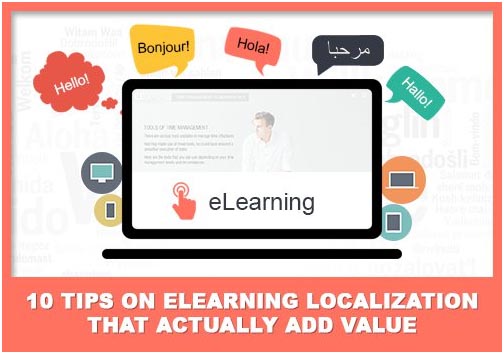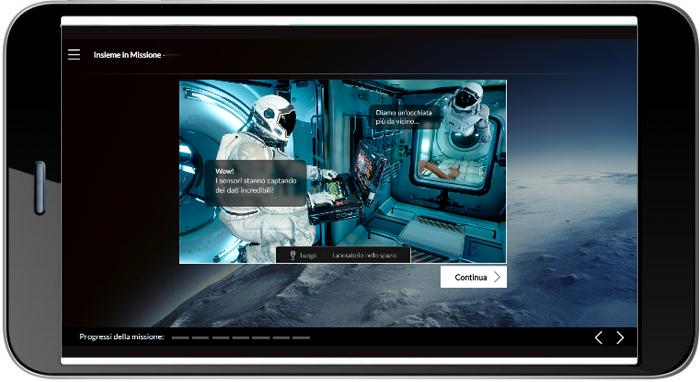
The localization of eLearning courses to reach a global audience is a well-established practice. However, successful localization needs to look at the entire development process (rather than see this as a translation exercise) and plan for several other factors that will ensure high readability. Moreover, localization when implemented accurately leads to higher accessibility, potential market expansion, favorable brand perception, and enhanced customer experience, to name a few. Through this article, you will learn 10 tips on eLearning localization that actually add value to your mandate.
What is eLearning Localization?
eLearning localization is the process of adapting a product, course, or module to a particular language, culture, and a desired “look-and-feel”. eLearning localization could be seen as language translation adapted to a geographic region in which the product is intended to be used. Localization is a necessity for organizations that are, ambitious and want to perform well in diverse markets, invested in being accessible, interested in enhancing customer experience and engagement, while also staying competitive in today’s dynamic environment. The value of localization in eLearning can be summed up effectively through this quote by Nelson Mandela:
“ If you talk to a man in a language he understands, that goes to his head. If you talk to him in his language, that goes to his heart.” Some key components of localization are translation, cultural adaptation, regional conventions and formatting, all of which will be discussed at further length throughout the course of this article.
Difference Between Localization and Translation
Although localization and translation are similar, there is a distinction between the two. Translation describes the process of converting text from one language to another, with the aim of retaining the meaning and message of the source text as much as possible. Localization on the other hand, can be understood to encompass translation while also involving other nuances beyond linguistic elements such as, cultural nuances, modification of graphics, interfaces, images, and in some cases, strategies as well. All of which is done with the aim that a localized asset will deliver a more culturally relevant experience to the intended target market and thus boost the levels of satisfaction and engagement. In conclusion, translation primarily aims to preserve meaning with just language conversion, whereas localization supplements translation with a more holistic adaptation to the desired language while also paying attention to other nuances.
The Need for eLearning Localization
There are many advantages to eLearning localization, some of which are:
- Higher Accessibility: Learning content that has been localized implies that, the material has been made more easily accessible to the learners for whom it was intended, thus significantly lowering the barrier of who can access and benefit from this material.
- Boosts Engagement: It is common knowledge that learning is most effective when the medium of instruction is a language that learners are comfortable with, if not proficient in. Interacting with learning material in a language they prefer is shown to boost learners’ engagement with the course and the information they retain from it.
- Cultural Relevance: For learning content to be localized means for the content to incorporate the cultural references and be sensitive to the nuances of the intended audience. This could be an important factor while illustrating a concept with examples, where the examples could be made more relatable and relevant by including closer-to-home scenarios and idioms.
- Market Expansion: It might seem like localization comes with an investment of capital, which could be true, but with strategic planning and strategizing it could also be directed toward the aim of reaching and appealing to a wider market, this could attract and bring in new potential clients and help scale the business.
- Competitive Advantage: Offering the option and service of localization, can be used as a differentiating factor by organizations, thereby offering courses that are inclusive, culturally sensitive, and a more effective and holistic learning experience. All of which is a social currency in today’s world.
Any eLearning offering is ultimately of little value if it doesn’t benefit the organization in any way, which is why it is important to note that, apart from the aforementioned, localization of learning material helps boost the retention and ability of the workforce for whom the material is intended, and offers a good return on investment.
We have been providing eLearning localization services for over a decade now and have localized hundreds of eLearning and mobile learning courses into 26 global languages so far. What we have noted is that localization should not be an after-thought to your primary development of eLearning. Instead, localization needs processing beyond translation and/or audio integration with another language. In fact, here are 3 examples that highlight the effectiveness of localization in the context of corporate training and learning.
Example 1: Skilling Economically Weaker Sections of Indian Society for Jobs
The Background: A Facilities Management organization in India wanted to design and develop eLearning modules to skill the economically weaker individuals to build their capacity for different activities undertaken for facility management – Brass Polishing Process, Cabin Cleaning Process, Main Gate and Auditorium Management at an Educational Institution
Our Solution: We developed an application-based eLearning solution in regional language – Hindi. The localized language helped learners easily grasp how a task is done, including the dos and don’ts. The onscreen text strategy included short and crisp phrases that the target audience could relate with. Scenario-based knowledge checks were also included.
The Impact: The post-training survey that was taken by over 600 learners has shown that the skills level of the learners has gone-up, which is evident from lesser accidents, faster completion of tasks and better CSAT scores.
Example 2: Skilling underwriters and claim professionals of a Global Insurance Provider
The Background: An Insurance provider wanted to educate underwriters and claim professionals on basic medical knowledge. This would help the underwriters and claims professionals to assess the client cases appropriately. Moreover, the Global Insurance provider expanded its operations to different geographical locations. Therefore, this led to a requirement for the learning solution to be localized.
Our Solution: Based on the requirement, we designed an online learning solution. The solution consisted of scenario-based case questions to ensure that any client cases were appropriately processed using the new content. We extensively used medical images to help the audience to understand the content better.
The modules were then localized into different languages to ensure that employees were better engaged with the training material.
The Impact: The organization was able to ensure that employees in different locations had access to content in a local language. This helped underwriters and claim professionals to process the claims efficiently as well as increased customer satisfaction scores.
Example 3: Upskilling of Eyewear Salespersons
The Background: A European eyewear company renowned for its minimalist designs wanted to develop a mobile-first responsive space-themed gamified eLearning course that allowed new and experienced salespersons to explain the product and lens features of the latest eyewear collection and to use them in their sales conversations.
Our Solution: EI developed a mobile-responsive course that catered to multiple target audiences across the globe and across multiple devices. By introducing a language selector at the start of the program, users could interact with the content in their preferred language. The course was localized in its entirety for Chinese, Spanish, Dutch, French, Italian, and Portuguese languages. The on-screen text and narration were also replaced in videos wherever possible.
The Impact: The feedback received from eye care professionals for the eLearning program was overwhelmingly positive, with many praising the program’s comprehensive content, user-friendly interface, and interactive learning modules.
Key Factors to Consider While Localizing Training Content
Since the primary aim of localization is for the learning material to completely adapt and take the shape of the nuances and linguistic preferences of the culture and language of its intended audience, there are many small but important elements that need to be factored in during the Localization process. They are as follows:
- Text localization: To ensure that the text is culturally sensitive, appropriate and accurate.
- Voice-overs: To ensure that the voice artist is a professional and a native speaker, and is proficient in the language of localization
- Multimedia: To ensure that all multimedia, including videos, graphics, images, are culturally relevant and sensitive.
- Subtitle localization: To ensure that the written script of the language of localization is depicted in the appropriate script.
- Slang, idioms, and colloquialisms: To ensure the inclusion of culturally sensitive slang, idioms, and colloquialisms that help learners relate better.
- Examples: To ensure the inclusion of examples that are most relevant and sensitive.
- Symbols, icons, and colors: To ensure that accents, dipthongs, and other linguistic elements are represented appropriately.
- Units of measurements, currency, number, date, and time formats: To ensure the usage of the correct units of measurement.
- Factoring for legal requirements: To ensure that the material is in compliance with the local and legal requirements
Tips for Effective Implementation of eLearning Localization
Successful eLearning localization projects require specific planning for each of the following phases mentioned below, so that the entire course material is holistically and substantially localized, as opposed to it being an afterthought and surface level attempt.
- Estimation phase
- Pre-planning phase
- Development phase
- Translation and Audio recording phase
- Integrating phase
Tips for the estimation phase:
- Tip 1: Ascertaining the deliverables and the scope of the project accurately:
Understand and communicate the requirements of the project clearly, this includes identifying the language/ languages that the material needs to be localized into, the user interface, content, audio and transcript, video, character images, as well as the glossary.
- Tip 2: Elements to be localized:
Be aware of structural elements such as onscreen text word count as well as the audio word count, the mode of delivery, the number of review and testing cycles, whether it is a single SCO per language or multi- language SCO. Knowing this information before beginning action on the project will help put effective workflows in place that will aid in a confusion free way of navigating the project.
Tips for the pre- planning phase:
- Tip 3: Understand the target audience thoroughly:
Adequate research must be done to authentically understand the target audience that the localized material is intended towards, cultural nuances, colloquialism, perception of controversial and important things must be noted. The goals of the localization must be defined and adhered to as the north star of the project.
- Tip 4: Make note of the multimedia elements that need to be featured:
Considering the holistic nature of localization, ensure that the multimedia elements, such as pictures, graphics, signs, symbols, etc., are all accounted for. This ensures that localization is incorporated from the ground up and substantially throughout the course.
- Tip 5: Allocate resources:
Once there is an awareness of the goal of the project, the scope of it, and the elements that populate it, relevant source material for reference must be gathered for the process. After which resources can be allocated and the best approach to go about it.
Tips for the development phase:
- Tip 6: Ensure to do a sensitivity read:
A novel practice that has emerged in recent times, while publishing a piece of media, is to involve a sensitivity reader. A sensitivity reader is tasked with going through the material and paying attention to anything that could read as uninformed, offensive , or can even be perceived as a slight. Considering the importance of ensuring we are politically correct and unknowingly misrepresent any party, involving a sensitivity reader would be a sound decision.
- Tip 7: Identify the elements that resist localization:
At times, there could be certain elements that are harder to localize or resist accurate localization, this could be examples that are steeped in a context and can’t be explained otherwise, formats, or units of measurement. Identify these elements so they can be done away with or replaced with other alternatives.
Tips for the translation and audio recording phase:
- Tip 8: Ensure to hire a professional native- speaker for the audio recordings:
Every language has its own unique pronunciations, colloquialisms, and nuances. In order for all this to be carried into the material successfully, it is best to hire a professional native- speaker of the language that the course needs to be localized to. Furthermore, including a linguistic reviewer to validate the annunciations, pronunciations, etc.,
- Tip 9: Include a glossary and style guide for translators and audio recorders:
Since there will be elements in the course material that could possibly be unfamiliar to the translators and audio recorders, it would be good practice to offer them a glossary and style guide to help them get context.
Tips for the integration phase:
- Tip 10: Test functionalities and ensure to give it a final review:
After the localization is complete, ensure to check that all the functional elements of the course have been migrated appropriately, conduct a final review, and make changes if there are any.
Key issues you may face during localization
Some issues that may crop up during the localization but can be avoided by taking some efforts, are as follows:
- Regulatory compliances: Ensure to take into consideration copyright laws and industry standards.
- Lack of adequate feedback to cultural nuances: Ensure to understand the norms and specifications of a particular language and the culture of the target audience and get adequate feedback from relevant experts for the same.
- Linguistic quality: Ensure to make sure the pronunciations, translations of idioms/ phrases, and accents are of standard quality.
Parting thoughts
I hope this article is useful and these 10 tips on eLearning localization will actually add value to your localization projects. Please reach out to me if you have any questions or need support in localization projects.















